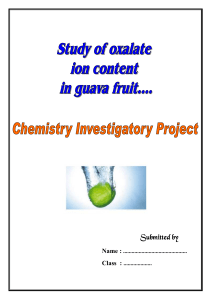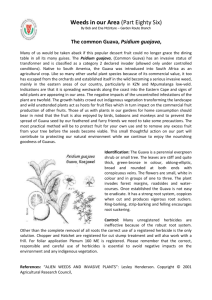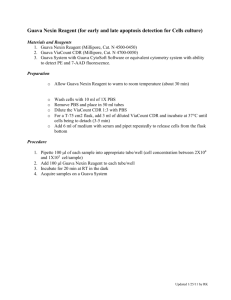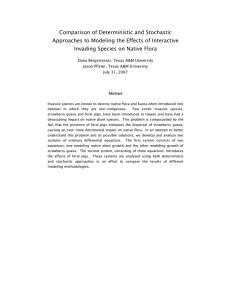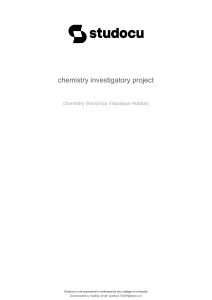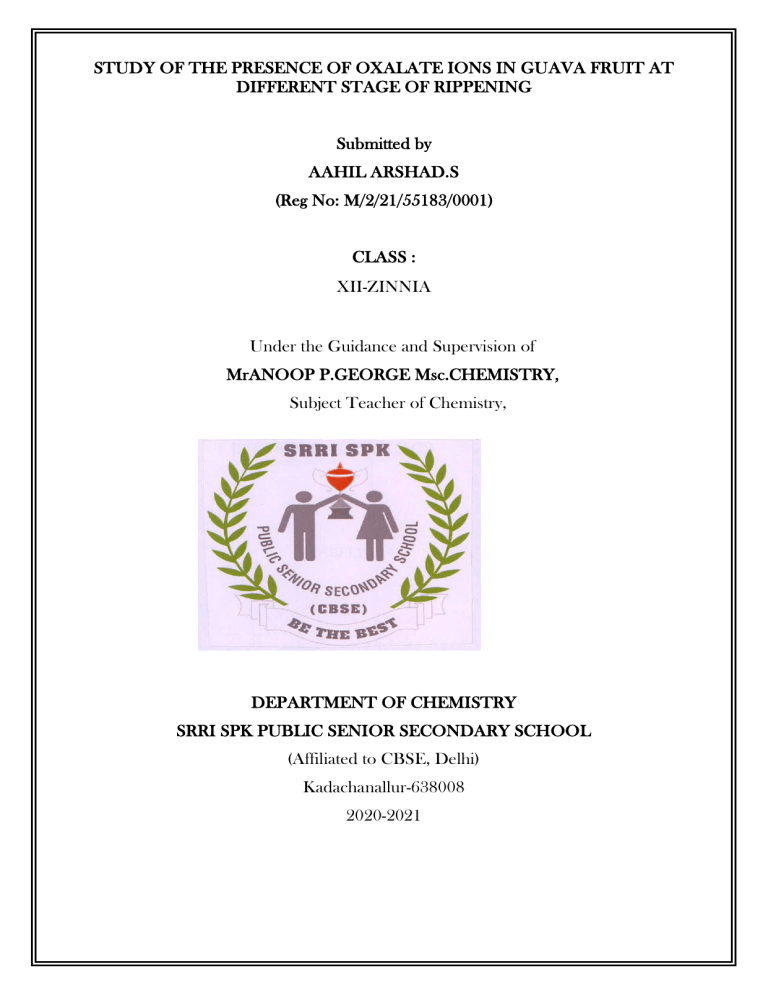
STUDY OF THE PRESENCE OF OXALATE IONS IN GUAVA FRUIT AT DIFFERENT STAGE OF RIPPENING Submitted by AAHIL ARSHAD.S (Reg No: M/2/21/55183/0001) CLASS : XII-ZINNIA Under the Guidance and Supervision of MrANOOP P.GEORGE Msc.CHEMISTRY, Subject Teacher of Chemistry, DEPARTMENT OF CHEMISTRY SRRI SPK PUBLIC SENIOR SECONDARY SCHOOL (Affiliated to CBSE, Delhi) Kadachanallur-638008 2020-2021 CERTIFICATE This is to certify that AAHIL ARSHAD.S (Registration No: M/2/21/55183/0001) student of class XII-ZINNIA has successfully completed the research on the below mentioned project under the guidance of Mr.ANOOP P.GEORGE Msc.CHEMISTRY., during the year 2020-21 in partial fulfillment of Chemistry practical examination conducted by AISSCE, New Delhi. Signature of Internal Examiner Date: Signature of External Examiner Principal ACKNOWLEDGEMENT In the accomplishment of this project successfully, many people have best owned upon me their blessings and the heart pledged support, this time I am utilizing to thank all the people who have been concerned with project. Primarily I would thank god for being able to complete this project with success. Then I would like to thank my principal and chemistry teacher whose valuable guidance has been the ones that helped me patch this project and make it full proof success his suggestions and his instructions has served as the major contributor towards the completion of the project. Then I would like to thank my parents and friends who have helped me with their valuable suggestions and guidance has been helpful in various phases of the completion of the project. Contents o Aim of the project o Introduction o Theory o Requirements o Chemical Equations o Procedure o Precautions o Observations o Calculations o Conclusions AIM To study the presence of oxalate ions in guava fruit at different stages of ripening. G uava is a common sweet fruit found in India and many places around the world. Guavas are plants in the Myrtle family (Myrtaceae) genus Psidium (meaning "pomegranate" in Latin), which contains about 100 species of tropical shrub. On ripening it turns yellow in color. Rich in vitamin C, this fruit is a rich source of oxalate ions whose content varies during the different stages of ripening. other Guavas have a pronounced and typical fragrance, similar to lemon rind but less in strength. What is oxalate? I t is a carboxylic acid, primarily found in plants and animals. It is not an essential moleculeand is excreted fromour body, unchanged. Our body either produces oxalate on its own or converts other molecules like Vitamin C to oxalate. External sources like food also contribute to the accumulation of oxalate in our body. The oxalate present in the body is excreted in the form of urine as waste. Too much of oxalate in our urine results in a medical condition called hyperoxaluria, commonly referred to as kidney stones. Diet is looked upon as a preventive measure in addition to medication to treat kidney stones. O Theory xalate ions are extracted from the fruit by boiling pulp with dilute H2SO4. The oxalate ions are estimated volumetrically, by titrating the solution with KMnO4 solution. A reagent, called the titrant, of a known concentration (a standard solution) and volume is used to react with a solution of the analyte or titrand, whose concentration is not known. Using a calibrated burette or chemistry pipetting syringe to add the titrant, it is possible to determine the exact amount that has been consumed when the endpoint is reached. The endpoint is the point at which the titration is complete, as determined by an indicator. This is ideally the same volume as the equivalence point. T he volume of added titrant at which the number of moles of titrant is equal to the number of moles of analyte, or some multiple thereof (as in polyprotic acids). In the classic strong acid-strong base titration, the endpoint of a titration is the point at which the pH of the reactant is just about equal to 7, and often when the solution takes on a persisting solid colour as in the pink of phenolphthalein indicator. Requirements (A)Apparatus 100 ml measuring flask Pestle & Mortar Burette Funnel Beaker Weighingmachine (B) Chemicals 1. dil. H2SO4 (C) Guava fruits at different stages of ripening. Filter Papers 2. (N/10) KMnO4 solution Chemical Equations Molecular Equations Ionic Equations Procedure (1)Weighed 50 g of fresh guava and crushed it to a fine pulp using pestle and mortar. (2)Transferredthecrushed pulp to a beaker and added about 50 ml dilute H2SO4 to it. (3)Boiled the content for about 10 minutes. Cooled and filtered the contents in a 100 ml measuring flask. (4)Made up the volume 100 ml by adding ample amount of distilled water. (5)Took 20 ml of the solution from the flask and added 20 ml of dilute sulphuric acid to it. (6)Heated the mixture to about 600 C and titrated it against (n/10) KMnO4 solution taken in a burette till the end point had an appearance of pink colour. (7) Repeated the above experiment with 50 g of 1day, 2 day and 3 day old guava fruits. Precautions 1. There should be no parallax while taking measurements. 2. Spillage of chemicals should be checked. 3. Avoid the use of burette having a rubber tap as KMnO4attacksrubber. 4. In order to get some idea about the temperature of the solution touchthe flask with the back side of your hand. When it becomes unbearable totouch, the required temperature is reached. 5. Add about an equal volume of dil. H2SO4to the guava extract tobe titrated (say a full test tube) before adding KMnO4. 6. Read the upper meniscus while taking burette reading withKMnO4 solution. 7. In case, on addition of KMnO4a brown ppt. appears, this showsthat either H2SO4has not been added or has been added ininsufficient amount. In such a case, throw away the solutionand titrate again. Observations 1. 2. 3. 4. Weight of the guava fruit for each time was 50 g. Volume of guava extract taken for each titration was 20 ml. Normality of KMnO4 solution was (1/10). END POINT: Colour Changes to pink Guava Burette Final Volume of Concurrent Solution reading Reading KMnO4 Reading Initial Raw 150 18 132 136.06 Semi-ripened 150 13 137 Ripened 150 10.8 139.2 1) For raw guava N1V1 = N2V2 N1 x 10 = (1/10) x132 1/10 x Normality of oxalate = (x/100) = strength of oxalate in fresh guava extract= normality x Eq. mass of oxalate ion = 1.32/100 x 44g/litre of diluted extract =0.581g L-1 2) For semi ripened guava (1 day old). Strength of oxalate in one day old guava extract = (1.37 /100) x 44g/litre of diluted extract =0.603g L-1 3) For ripened guava Strength of oxalate in fresh guava extract 44g/litre of diluted extract = 0.612g L-1 = ( 1.39/100) x (a) The normality of oxalate ions of; (i) Fresh guava solution is = 1.32 ml (ii) Semi-ripen guava solution is = 1.37 ml (iii) Ripened guava solution is = 1.39ml (b)The strength of oxalate ions of; (i) Fresh guava solution is =0.58ml (ii) Semi-ripened guava is =0.60 ml (iii) Ripened guava is = 0.61 ml The content of oxalate ions in guava was found to be 59.67 per cent, which is close to the literature value of 60 percent. It was also noticed that the content of oxalic ions grows with ripening of guava. 1. Search engines used: www.google.com www.wikipedia.com www.reader.google.com www.labs.google.com www.quora.com 2. Practical Chemistry by Laxmi Publications. 3. The Family Encyclopedia by Dorling Kindersley.

